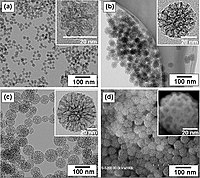
Photo from wikipedia
This study proposes appropriate dispersants for dispersing aluminum-doped zinc oxide (AZO) nanopowder in the commonly used organic solvent- dimethylacetamide (DMAC). The dispersion efficiencies and stabilization mechanisms of four DMAC-soluble dispersants,… Click to show full abstract
This study proposes appropriate dispersants for dispersing aluminum-doped zinc oxide (AZO) nanopowder in the commonly used organic solvent- dimethylacetamide (DMAC). The dispersion efficiencies and stabilization mechanisms of four DMAC-soluble dispersants, poly(acrylic acid) (PAA), polyethyleneimine (PEI), poly(vinyl alcohol) (PVA), and poly(vinyl pyrrolidone) (PVP), are compared. The non-polyelectrolyte-based PVA and PVP surprisingly exhibit greater efficiency than the polyelectrolyte-based PAA and PEI. This is because the nano AZO is soft-agglomerated in DMAC and easily de-agglomerated by the application of ultrasonic power; therefore, the increased viscosity contributed from additions of PVA and PVP efficiently prevent re-agglomeration and sedimentation of the nanopowder. This stabilization mechanism is evidenced by an experimental analysis of zeta potentials and rheology and also by theoretical calculations based on Stokes’ law. This article is protected by copyright. All rights reserved.
Journal Title: Journal of the American Ceramic Society
Year Published: 2017
Link to full text (if available)
Share on Social Media: Sign Up to like & get
recommendations!